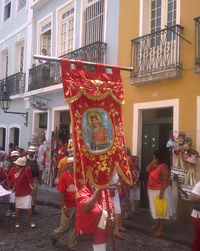Message from Brazil 2 - Viva Santa Barbara! (Que Viva Xangô!)
Tagged with: Santa Barbara Salvador Brazil Bahia Rosario dos Pretos Barroquinha Candomble Umbanda Caruru Iansa Ogum Oaxaguia Pelourinho orixas Xango
On December 4th each year, 'soteropolitanos' (people from Salvador) devoted to Catholicism, Evangelism, Candomble, Umbanda and various other religions come together to celebrate A Festa de Santa Barbara - one of the most popular festivals of Salvador's religious calendar. Today's the day, and it's RIDICULOUSLY HOT! I may actually melt, but hearing about the snow back home, reckon I should keep schtum!
The day begins early at 5am with fireworks at dawn, (I missed this part, for some reason), then there's a mass at Igreja de Nossa Senhora do Rosário dos Pretos (Our Lady of the Black People's Rosary), at 7am.
So many people come from across the city to pray that another mass is then held outside in the square. Here, devotees of Santa Barbara are joined by tourists, street vendors, camera crews and reporters, and almost everyone is wearing bright red and white. These are Santa Barbara's colours, and I wish I'd known - I felt a little embarrassed dressed in green and brown!
In Catholic hagiography Saint Barbara was a Greek who was tortured, mutilated and made to walk naked through the streets, and eventually executed by her own father Maximino Dioscoro, after he discovered her conversion to Christianity. On her way to the prison cell, Barbara asked her guards to break off a cherry tree branch that was yet to flower. She spent the days before her death praying and talking to the angels that she saw in her cell, and on the seventh day, the cherry branch burst into bloom. Barbara took this as a sign that she had chosen the right path, and went calmly to her beheading. Legend has it that the moment her head fell from her body under the axe, a beam of bright light or maybe lightning speared her father from above, killing him instantly.
Santa Barbara is the patron saint of firefighters, so naturally the procession takes a pit stop at the fire station in Barroquinha. She also looks after mountaineers and geologists - I guess there aren't any climbing walls or universities en route. As far as I know, revellers and devotees do not take it in turns to slide down the pole, but in my head that's what happens - I may write a letter to the local council and suggest the idea, what do you reckon?
When the procession arrives at Santa Barbara Market, the crowd is served with a traditional candomble dish called caruru. Made from okra, hot peppers, dried shrimp and palm oil, this simple and tasty dish is made in enormous amounts by communities throughout the city in the run up to December 4th, and there are hotly disputed contests to see who can cook the most, as their sign of devotion to the saint.
[Editor’s note: Santa Barbara is however also synonymous with the Warrior God, Xangô, of the Yoruba-derived afro-latin religions Candomble and Umbanda; Xangô’s colours are Red and White and he is also the orixa of Thunder and Lightning and virility, likes okra, and wields weapons such as the sword (like Barbara) and in particular the Double-Headed Axe; Xangô is an incredibly popular orixa (being the god of Music and Dance) especially with latin percussionists!].
Intermingled with the figure of Xangô/Santa Barbara is the Candomble goddess Iansã (orixa of hurricane and change). According to one legend, Iansã was once the wife of the blacksmith Ogum, who served Oxaguiã - a powerful king who reigned over an enormous and much disputed land. At Ogum’s side, Iansã's powerful breath fed the flames of his forge, so that he could make enough arms for King Oxaguiã to win wars against his enemies. When Oxaguiã paid an honorary visit to Ogum, to congratulate him for his war efforts, he fell instantly in love with the beautiful Iansã, and seduced her into leaving her husband to join him in his castle.
When war came again to Oxaguiã's kingdom, he returned to the blacksmith in need of more arms. Ogum protested that without Iansã by his side, forging so many swords would prove impossible, but the king reassured him that he could fix it. Returning home, he made his stolen mistress climb the highest tower of the castle, from where Iansã found the courage to blow so hard that her breath became a wind, before which the entire kingdom lay prostrate, as Ogum set to work above the fires of his now blazing forge, on the other side of the city. Her breath arrived at his forge at exactly the correct amount to fan the flames. The weapons were made, the war was won, and the king was happy. Not happy enough, apparently, to return Iansã to her rightful and deserving husband, but there's something quite refreshing about an ancient legend involving open and complicit relationships, don't you think?
Anyway, the procession is still going on outside, in fact there are several cavalcades of dancers, brass bands and giant puppets parading around Pelourinho - and more red lycra than you could shake your booty at. I'm off across town to get my some hearty food, outside of this craziness - I feel a plate of caruru and a cheeky slide down the fireman's pole coming on!
Tessa Burwood for WorldMusic.co.uk
1











